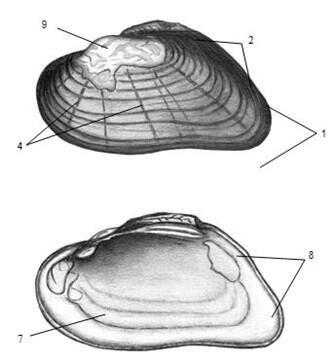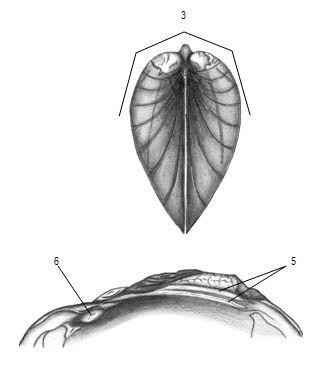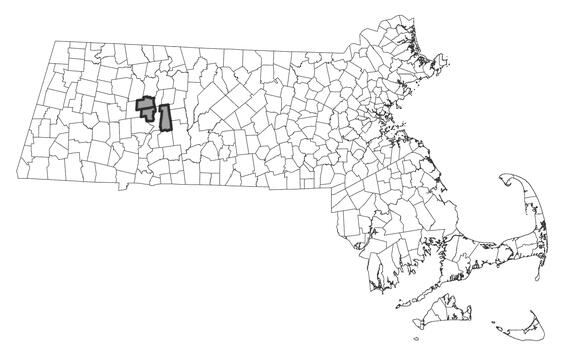- Scientific name: Alasmidonta heterodon
- Species of Greatest Conservation Need (MA State Wildlife Action Plan)
- Endangered (MA Endangered Species Act)
- Endangered (US Endangered Species Act)
Description
Dwarf wedgemussel
The dwarf wedgemussel is a small species that rarely exceeds 45 mm (1.75 in) in length; the largest known specimens came from a New Hampshire river and were 56 mm (2.2 in) long. The shell is triangular or trapezoidal. The posterior end of the shell tapers to a rounded point (1) and has been described as “wedge-shaped,” although this distinctive shape varies with the size and sex of an individual. There is a prominent rounded ridge along the dorso-posterior slope (2). The valves are usually laterally compressed to slightly inflated (3); mature females tend to be more inflated than males. The shell is smooth and may be yellowish-brown, olive-brown, or brownish-black in color. Faint greenish rays (4) are evident on the shells of juveniles and light-colored adults. Hinge teeth are present but delicate. This is the only species in North America that has two lateral teeth (5) on the right valve and one lateral tooth on the left valve (all other species with lateral teeth have the opposite configuration). The dwarf wedgemussel also has pseudocardinal teeth—two on the left valve and one (6) on the right valve. The color of the nacre (7) is bluish-white and often iridescent along the posterior margin (8). The foot is often a pale beige or slightly orange color.
The small size, wedge shape, and hinge tooth morphology of this species make shells easily distinguishable from all other species in New England. None of the species it might be confused with (brook floater, triangle floater, and creeper) have lateral teeth. However, live animals, which are often identified based on variable features such as shape or color, can sometimes be difficult to distinguish from a young brook floater, triangle floater, or creeper. Unlike brook floater, dwarf wedgemussel lacks corrugations along the dorso-posterior slope and its foot is not cantaloupe colored. The triangle floater is more subovate and laterally inflated than the dwarf wedgemussel and has coarse uneven beak sculpturing (9). To the novice, it is most difficult to distinguish between dwarf wedgemussel and young creeper because their shape and color are similar. The dwarf wedgemussel is a federally Endangered species and it is imperative that animals are not harmed or removed from the water. Furthermore, commonly confused species are also protected in Massachusetts and an expert should always be consulted.


Illustrations by Ethan Nedeau.
Life cycle and behavior
The dwarf wedgemussel are essentially sedentary filter feeders that spend most of their lives partially burrowed into the bottoms of rivers and streams. Like all freshwater mussels, larvae (called glochidia) of the dwarf wedgemussel must attach to the gills or fins of a vertebrate host to develop into juveniles. The tessellated darter is considered the primary host in the Connecticut River watershed and its range is most congruent with that of the dwarf wedgemussel, but several other fish (e.g., slimy sculpin) have been identified as potential hosts (Nedeau 2008). Tessellated darters do not move very far—usually less than 100 meters during their short lives—thus the dispersal ability of dwarf wedgemussels may be low and the rate at which they might recolonize former habitat is slow (McLain and Ross 2005). The life span of a dwarf wedgemussel is considered less than 12 years (Michaelson and Neves 1995), which is young compared with many other freshwater mussel species in the Northeast. Short life spans, low fecundity, high degree of host specificity, limited dispersal ability of its primary host, and low population densities likely all contribute to the Endangered status of the dwarf wedgemussel.
Distribution and abundance
The historic range of the dwarf wedgemussel included 70 locations in 15 major Atlantic coastal watersheds from North Carolina to eastern New Brunswick. By the early 1990s, its range was thought to have shrunk to approximately 20 locations in eight watersheds (USFWS 1993). In the last 25 years, biologists have rediscovered populations that were considered extirpated and discovered entirely new populations (Nedeau 2006). It currently occupies 15 major watersheds, with the largest populations in the Connecticut River watershed (Nedeau 2008). In Massachusetts, it was historically known from the mainstem Connecticut River, several of its tributaries, and four other rivers in the southeastern and northeastern parts of the state. It is now believed extirpated from most of these sites (USFWS 1993) and recent (<25 years) records are confined to two tributaries to the Connecticut River. Dwarf wedgemussel occur discontinuously within these river systems from low to relatively high population densities. In one watershed the species shows population viability throughout most of the river. In contrast, the species is at low densities and with a limited distribution in the other river, raising concern about population viability.
The dwarf wedgemussel is one of the most endangered mussels in all of northeastern North America. It is listed as Endangered in Massachusetts and protected under the Massachusetts Endangered Species Act (MG.L. c.131A) and its implementing regulations (321 CMR 10.00). It is also the only federally endangered mussel in the state.

Distribution in Massachusetts.
1999-2024
Based on records in the Natural Heritage Database.
Habitat
The dwarf wedgemussel is a generalist in terms of its preference for stream size and substrate (Nedeau 2008). It inhabits small streams less than five meters wide to large rivers more than 100 meters wide. It is found in a variety of substrate types including clay, sand, gravel, and pebble, and often in areas of rivers with large amounts of silt (e.g., depositional areas and near banks). The species inhabits shallow water along streambanks and can move laterally or horizontally in the substrate as water levels fluctuate, but they have also been found at depths of 25 feet in the Connecticut River. The dwarf wedgemussel does not inhabit lakes or reservoirs but may temporarily occur in small impoundments created by run-of-river lowhead dams, beaver dams, or by natural landforms that create deep and stable stream reaches. An increasing number of published studies and field observations suggest that stable flow and substrate (Maloney et al. 2012), cool to cold-water (Galbraith et al. 2020), and aragonite concentration (Campbell and Prestegaard 2016) are critical for this species (reviewed in Nedeau 2008). Dwarf wedgemussel are often patchily distributed in rivers, especially those with highly variable physical habitat and fragmenting features such as dams and culverts. Identifying and protecting these patches are critical for conserving the species.
Healthy habitats are vital for supporting native wildlife and plants. Explore habitats and learn about conservation and restoration in Massachusetts.
Low gradient, stable stream habitat for dwarf wedgemussel.
Threats
Because dwarf wedgemussel are essentially sedentary filter feeders, they are unable to flee from degraded environments and are vulnerable to the alterations of waterways. Some of the many threats to the dwarf wedgemussel and its habitat in Massachusetts include: nutrient enrichment, sedimentation, point-source pollution, road salts, alteration of natural flow regimes (increased discharge), surface and groundwater withdrawal, encroachment of river corridors by development, non-native and invasive species, habitat fragmentation caused by dams and road-stream crossings, and a legacy of land use that has greatly altered the natural dynamics of river corridors (Nedeau 2008). Bacterial pathogens and nitrogenous wastes can cause problems downslope and downstream of agricultural lands; ammonia-nitrogen is considered particularly toxic to mussels. In 2001, runoff from a small farm killed more than 25 dwarf wedgemussel and hundreds of other mussels in a river in Massachusetts. Livestock allowed access to streams can severely damage mussel communities by trampling mussels, causing sedimentation, destabilizing streambanks, and defecating in the water. In addition, the long-term effects of regional or global problems such as acidic precipitation, mercury, and climate change are considered severe but little empirical data relates these stressors to mussel populations. This species is one the most thermally sensitive species in Massachusetts and may be susceptible to increased summer temperatures and drought via climate change. Further, predicted increased precipitation in fall, winter, and spring months may destabilize substrates. As local populations of dwarf wedgemussel decline and/or become extirpated in response to these threats, dispersal distances between populations increase, weakening overall reproductive success, and ultimately genetic diversity.
Conservation
Survey and monitoring
Surveys are critically needed to monitor known populations, evaluate habitat, locate new populations, and assess population viability at various spatial scales (e.g., stream, watershed, state; Sterrett et al. 2018). Survey efforts in the past 10 years have redocumented the species in known extant watersheds and have failed to find new or historical populations using a combination of eDNA and snorkel surveys. Survey efforts should continue to search for new populations via physical and eDNA surveys and expand our knowledge on the species distribution in extant watersheds every 5 years. Long-term monitoring sites in extant watersheds should be established to acquire critical demographic and trend data and assess habitat changes and potential threats. Monitoring at these sites may occur annually in multi-year blocks or as needed.
Management
Discovery and protection of viable mussel populations is critical for the long-term conservation of freshwater mussels. Currently, much of the available mussel occurrence data are the result of limited presence/absence surveys at road crossings or other easily accessed points of entry. Regulatory protection under MESA only applies to rare species occurrences that are less than 25 years old, so that conservation and restoration efforts, as well as regulatory protection, can be effectively targeted. Other conservation and management recommendations include: maintain naturally variable river flow and limit water withdrawals; identify, mitigate, or eliminate sources of pollution to rivers; identify dispersal barriers (e.g., dams, impassable culverts) for host fish, especially those that fragment the species range within a river or watershed, and seek options to improve fish passage or remove the barrier; maintain adequate vegetated riparian buffer; protect or acquire land at high priority sites; restore populations through propagation and reintroduction at historical or suitable streams.
Research needs
Research needs for dwarf wedgemussel include population-level data on survival rate, mortality rate, individual growth rates, population size trends, age at reproduction, sex ratio, and age structure. This data will help develop population viability models to identify when populations may need active restoration via introduction of propagated mussels. Reintroduction of dwarf wedgemussel will require habitat suitability evaluation of historically occupied watersheds and potentially new sites. Additional research is needed on habitat suitability within occupied watersheds to address potential current factors limiting distribution including ammonia concentrations, beaver activity, water temperature, and host-fish availability. Climate change projections for water temperature and streamflow in occupied watersheds is also needed to assess current and future population risks. Further, research may be warranted to determine the potential impacts of invasion species present in nearby streams including basket clam (Corbicula fluminea), rusty crayfish (Faxonius rusticus) and nonnative fish like smallmouth bass (Micropterus dolomieu).
References
Campbell, C.A., and K.L Prestegaard. 2016. Physical and chemical constraints limit the habitat window for an endangered mussel. Hydrobiologia 772:77-91.
Galbraith, H.S., C.J. Blakeslee, D.E. Spooner, W.A. Lellis. 2020. A weight-of-evidence approach for defining thermal sensitivity in a federally endangered species. Aquatic Conservation Marine and Freshwater Ecosystems 30:540-553.
Lefevre, G., and W.C. Curtis. 1911. Metamorphosis without parasitism in the Unionidae. Science 33: 863-865.
Maloney, K.O., W.A. Lellis, R.M. Bennett, T.J. Waddle. 2012. Habitat persistence for sedentary organisms in managed rivers: the case for the federally endangered dwarf wedgemussel (Alasmidonta heterodon) in the Delaware River. Freshwater Biology 57:1315-1327.
McLain, D.C., and M.R. Ross. 2005. Reproduction based on local patch size of Alasmidonta heterodon and dispersal by its darter host in the Mill River, Massachusetts, USA. Journal of the North American Benthological Society 24:139-147.
Michaelson, D.L., and R.J. Neves. 1995. Life history and habitat of the endangered dwarf wedgemussel Alasmidonta heterodon (Bivalvia: Unionidae). Journal of the North American Benthological Society 14:324-340.
Nedeau, E.J. 2008. Freshwater Mussels and the Connecticut River Watershed. Connecticut River Watershed Council, Greenfield, Massachusetts. xviii+ 132 pp.
Nedeau, E.J. 2006. In Hopes the Dwarf Wedgemussel Survives. Gulf of Maine Times, Winter 2006.
Nedeau, E.J., and J. Victoria. 2003. A Field Guide to the Freshwater Mussels of Connecticut. Connecticut Department of Environmental Protection, Hartford, CT.
Nedeau, E.J., M.A. McCollough, and B.I. Swartz. 2000. The Freshwater Mussels of Maine. Maine Department of Inland Fisheries and Wildlife, Augusta, Maine.
Raithel, C.J., and R.H. Hartenstine. 2006. The Status of Freshwater Mussels in Rhode Island. Northeastern Naturalist 13(1): 103-116.
Sterrett, S. Roy, A., Hazelton P., Watson, B., Swartz, B., Russ T.R., Holst, L., Marchand, M., Wisniewski, J., Ashton, M. and Wicklow, B. 2018. Brook Floater Rapid Assessment Monitoring Protocol. U.S. Department of Interior, Fish and Wildlife Service, Cooperator Science Series FWS/CSS-132-2018, Washington, D.C.
Strayer, D.L., S.J. Sprague, and S. Claypool. 1996. A range-wide assessment of populations of Alasmidonta heterodon, an endangered freshwater mussel (Bivalvia: Unionidae). Journal of the North American Benthological Society 15(3): 308-317.
Vaughn, C. 1993. Can biogeographic models be used to predict the persistence of mussel populations in rivers? pp.117-122 in K.S Cummings, A.C. Buchanan and L.M. Koch (eds)., Conservation and Management of Freshwater Mussels: proceedings of a UMRCC symposium, 12-14 October 1992, St. Louis, Missouri. Upper Mississippi River Cons. Com., Rock Island, Illinois. 189 pp.
United States Fish and Wildlife Service (USFWS). 1993. Dwarf Wedge Mussel (Alasmidonta heterodon) Recovery Plan.
Contact
| Date published: | March 28, 2025 |
|---|